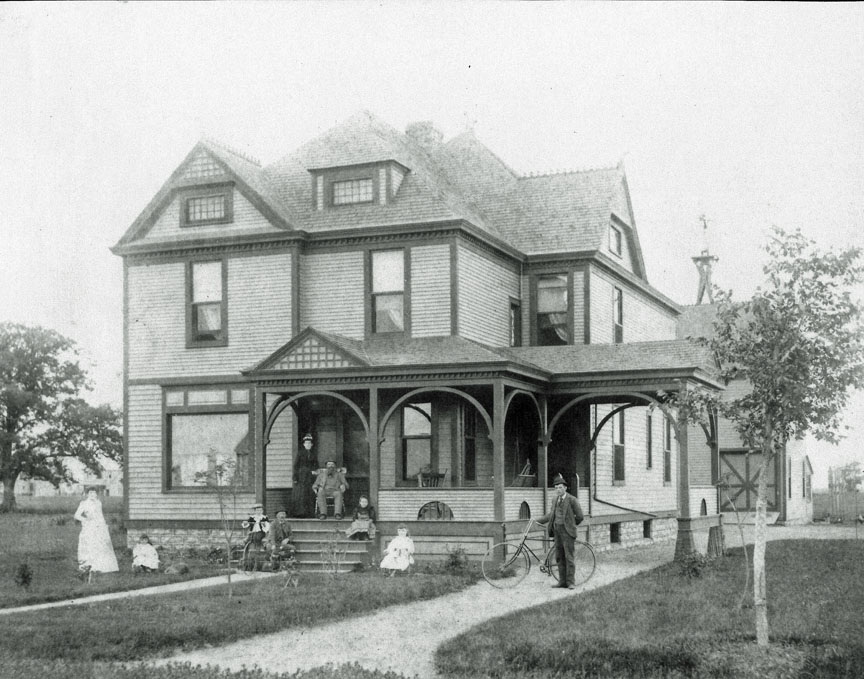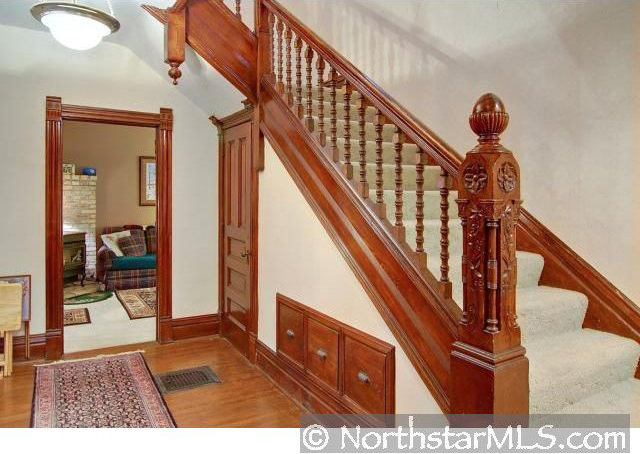In 1896, Joseph Hamilton built a large Victorian house, named “Sunnyside,” at 5900 Goodrich Ave. – the finest street in the Park. In 1899 Hamilton was said to have installed the first bathtub in the Village, made of zinc.
In 1920, residents of the house were Joseph’s widow Sarah, his widowed daughter-in-law, Rebecca, and his daughter Alice. When Sarah died in 1930, the house was left to daughters Alice and Pearl and son Horace.
In 1933-1937 the house was rented to the Forsyth family. Roberta Forsyth Wesley provided this detailed recollection of the home for Something in the Water:
The Hamilton home was three stories tall with a wrap-around screened porch across the front and around one side. A matching barn was at the rear. The frame home was painted a tannish-yellow. Only two houses were on that block, separated by a big yard and a vegetable garden. There were sidewalks and a strip of grass to mow between the sidewalk and the street, but no curbing. On one side of the house there was an attached carriage passageway with roof and ornate, elaborate gingerbread trim. Steps led from the passageway to the side porch.
The windows – and there were many – had wood screens and storm windows. Storms and screens were alternately stored in the large barn depending upon the season of the year. The storm windows had three holes in the bottom of the wood frames and served as ventilators. A wooden device covered the holes when they were not needed.
The front door was very ornate – heavy oak, with leaded, colored glass panels. I don’t recall a key for the door, nor was it ever locked. To reach the second floor from the front hall, you went up three steps to a landing, then turned left and proceeded to the upper floor. The landing had a stained glass window which looked out onto the front porch. The banister was ornate with carved acorns about the size of a head of lettuce at top and bottom. I remember well, because dusting that stairway and banister was one of my Saturday morning chores.
Another stairway in the back of the house led from the kitchen to the second and third floors. That back stairway was narrow, about two feet wide, a 180 degree spiral, dark and “spooky.” It opened with a door on the second floor near the bathroom. At that point it continued with another 180 degree spiral to the third floor. There was a long center hallway on the second floor leading from the top of the front stairs to the bathroom at the back of the house. My parents, brothers and sister had bedrooms here, but there were two or three rooms also “off-limits” and filled with furniture from the Hamilton estate.
The third floor was not partitioned off into rooms, but may have been used as servant quarters. It more or less resembled a loft. More furniture on that floor which belonged to previous occupants. We were not supposed to explore, but I do remember that there was a large buffet up there which we referred to as “the war-horse.” Why – I do not know. My brother, Jack, who was 8 or 9 years old at that time, remembers doing a lot of “reconnaissance” (I wouldn’t accuse him of “snooping”). He recalls a box filled with cancelled checks in the “war-horse” and says that there was another stained glass window which was positioned on the front of the house.
The bathroom had a big tank mounted on the wall over the toilet and a pull chain for flushing. The toilet seat was wooden, of course. The bathtub had claw feet, and there was a large white lavatory with wooden medicine cabinet over it. The one window overlooked the barn at the rear of the house.
On the first floor we had two big living rooms, a dining room, with separate closet for dishes, a den, the kitchen and a large pantry. We closed off the first living room, which we called a parlor, to conserve heat in the winter. The second living room had a big fireplace with huge mantle made of solid oak. The mantle had a beveled mirror and built-in bookcases. There were three, double pocket doors which slipped into the walls as desired. These doors, when opened, connected the two parlors, the den and the front hall. The sliding doors were fitted with brass hardware including a ring which was flush with the door and used to open and close the heavy doors.
All floors were hardwood, with linoleum in the kitchen. That room was huge! At the end of the sink was a hand pump, but I don’t remember whether or not it was used. We did have hot and cold faucets in the sink. There was a large walk-through pantry between the kitchen and the den. We had a “hired girl,” Evelyn, who was considered to the part of the family. She and I shared the den as our bedroom. Evelyn had an interest in 10-cent magazines with titles such as True Confessions and Romantic Love. She kept these hidden, because Dad would not have wanted that kind of material in his home and available to his soon to be teen-aged daughter. However, they were my source for sex education in those days and my reading them was a secret between Evelyn and me.
The dining room at the back of the house was also large. A beautiful Tiffany-type lamp hung from the ceiling over the table. Outside the kitchen door was a screened-in porch. It was always cluttered with stuff that was to be brought to or from the barn. Yes – the barn. It had a second floor, probably used as a hay loft at one time. The barn became a garage for the big old 1933 Pierce Arrow which my dad drove. Dad used railroad ties and dirt to build a ramp up from the ground to the floor of the barn. He had a rabbit hutch in the barn for a while and he raised rabbits for food. There was another separate building next to the barn, but neither Jack nor I can remember what it was used for. The property behind the barn sloped down to an open field. From the barn we were not far from the back end of the Freeland Grocery which faced Alabama Ave.
My brother Jack remembers the basement and the furnace because it was his job to stoke the furnace in the morning and “bank the coals” at night. He says that he had to practically crawl inside the big furnace to remove clinkers and ashes. There was a coal chute where the coal truck emptied fuel into the coal bin. At some point Dad installed an oil burner with a thermostat. That was a real convenience.
The house is now approaching 110 years old. I understand that it has been renovated by current owners, Greg and Karen Flatten. It is the pride of the Elmwood neighborhood. My recollections are strictly from the period 1933-1937. If the home could talk, there could well be many more interesting stories about Joseph Hamilton’s Mansion.


